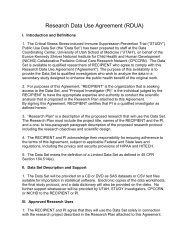CDC Definitions of Nosocomial Infections (PDF) - CPCCRN
CDC Definitions of Nosocomial Infections (PDF) - CPCCRN
CDC Definitions of Nosocomial Infections (PDF) - CPCCRN
You also want an ePaper? Increase the reach of your titles
YUMPU automatically turns print PDFs into web optimized ePapers that Google loves.
Chapter 94: Surveillance <strong>of</strong> <strong>Nosocomial</strong> <strong>Infections</strong> 1673symptoms with no other recognized cause: fever(38C), urgency, frequency, dysuria, or suprapubictendernessandat least one <strong>of</strong> the following:a. Positive dipstick for leukocyte esterase and/ornitrateb. Pyuria (urine specimen with 10 WBC/mm 3or 3 WBC/high power field <strong>of</strong> unspun urine)c. Organisms seen on Gram stain <strong>of</strong> unspun urined. At least two urine cultures with repeated isolation<strong>of</strong> the same uropathogen (gram-negativebacteria or S. saprophyticus) with 10 2 colonies/mLin nonvoided specimense. 10 5 colonies/mL <strong>of</strong> a single uropathogen(gram-negative bacteria or S. saprophyticus) ina patient being treated with an effective antimicrobialagent for a urinary tract infectionf. Physician diagnosis <strong>of</strong> a urinary tract infectiong. Physician institutes appropriate therapy for aurinary tract infectionCriterion 3: Patient 1 year <strong>of</strong> age has at least one <strong>of</strong> the followingsigns or symptoms with no other recognizedcause: fever (38C), hypothermia(37C), apnea, bradycardia, dysuria, lethargy, orvomitingandpatient has a positive urine culture, that is, 10 5microorganisms per cm 3 <strong>of</strong> urine with no morethan two species <strong>of</strong> microorganisms.Criterion 4: Patient 1 year <strong>of</strong> age has at least one <strong>of</strong> the followingsigns or symptoms with no other recognizedcause: fever (38C), hypothermia(37C), apnea, bradycardia, dysuria, lethargy, orvomitingandat least one <strong>of</strong> the following:a. Positive dipstick for leukocyte esterase and/ornitrateb. Pyuria (urine specimen with 10 WBC/mm 3or 3 WBC/high power field <strong>of</strong> unspun urine)c. Organisms seen on Gram stain <strong>of</strong> unspun urined. At least two urine cultures with repeated isolation<strong>of</strong> the same uropathogen (gram-negativebacteria or S. saprophyticus) with 10 2 colonies/mLin nonvoided specimense. 10 5 colonies/mL <strong>of</strong> a single uropathogen(gram-negative bacteria or S. saprophyticus) ina patient being treated with an effective antimicrobialagent for a urinary tract infectionf. Physician diagnosis <strong>of</strong> a urinary tract infectiong. Physician institutes appropriate therapy for aurinary tract infectionCOMMENTS:A positive culture <strong>of</strong> a urinary catheter tip is not an acceptablelaboratory test to diagnose a urinary tract infection.Urine cultures must be obtained using appropriate technique,such as clean catch collection or catheterization.In infants, a urine culture should be obtained by bladdercatheterization or suprapubic aspiration; a positive urine culturefrom a bag specimen is unreliable and should be confirmedby a specimen aseptically obtained by catheterizationor suprapubic aspiration.INFECTION SITE: Asymptomatic bacteriuriaCODE: UTI-ASBDEFINITION: An asymptomatic bacteriuria must meet at leastone <strong>of</strong> the following criteria:Criterion 1: Patient has had an indwelling urinary catheterwithin 7 days before the cultureandpatient has a positive urine culture, that is, 10 5microorganisms per cm 3 <strong>of</strong> urine with no morethan two species <strong>of</strong> microorganismsandpatient has no fever (38C), urgency, frequency,dysuria, or suprapubic tenderness.Criterion 2: Patient has not had an indwelling urinarycatheter within 7 days before the first positivecultureandpatient has had at least two positive urine cultures,that is, 10 5 microorganisms per cm 3 <strong>of</strong> urinewith repeated isolation <strong>of</strong> the same microorganismand no more than two species <strong>of</strong> microorganismsandpatient has no fever (38C), urgency, frequency,dysuria, or suprapubic tenderness.COMMENTS:A positive culture <strong>of</strong> a urinary catheter tip is not an acceptablelaboratory test to diagnose bacteriuria.Urine cultures must be obtained using appropriate technique,such as clean catch collection or catheterization.INFECTION SITE: Other infections <strong>of</strong> the urinary tract (kidney,ureter, bladder, urethra, or tissues surrounding the retroperitonealor perinephric spaces)CODE: SUTI-OUTIDEFINITION: Other infections <strong>of</strong> the urinary tract must meetat least one <strong>of</strong> the following criteria:Criterion 1Patient has organisms isolated from culture <strong>of</strong>fluid (other than urine) or tissue from affected site.Criterion 2: Patient has an abscess or other evidence<strong>of</strong> infection seen on direct examination,during a surgical operation, or during a histopathologicexamination.Criterion 3: Patient has at least two <strong>of</strong> the following signs orsymptoms with no other recognized cause: fever(38C), localized pain, or localized tendernessat the involved siteandat least one <strong>of</strong> the following:a. Purulent drainage from affected site



